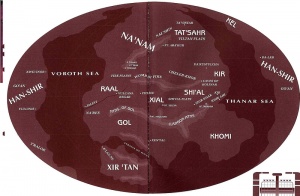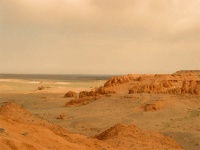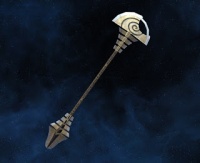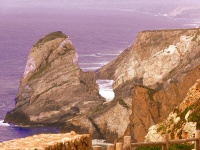More actions
mNo edit summary |
|||
| Line 8: | Line 8: | ||
== History == | == History == | ||
[[Image:Gol.jpg|thumb|left|Kalrenta Plateau]] | [[Image:Gol.jpg|thumb|200px|left|Kalrenta Plateau]] | ||
Mineral-rich by Vulcan standards, Gol has seen its share of warfare despite its inhospitable landscape. | Mineral-rich by Vulcan standards, Gol has seen its share of warfare despite its inhospitable landscape. | ||
| Line 46: | Line 46: | ||
=== Vulcan Institute of Defensive Arts === | === Vulcan Institute of Defensive Arts === | ||
[[Image:Ceremonial Lirpa.jpg|thumb|left|Ceremonial lirpa]] | [[Image:Ceremonial Lirpa.jpg|200px|thumb|left|Ceremonial lirpa]] | ||
| Line 66: | Line 66: | ||
=== Menal Haul-kur === | === Menal Haul-kur === | ||
[[Image:Gol-Haul-Kur.jpg|thumb|right|Cape Silver]] | [[Image:Gol-Haul-Kur.jpg|200px|thumb|right|Cape Silver]] | ||
If Vulcan has such a thing as a resort, it would be the southernmost tip of Gol province. Renowned for its windswept splendor, the area of Cape Haul-Kur features a microclimate drastically different from the only 50 kilometer distant desert. | If Vulcan has such a thing as a resort, it would be the southernmost tip of Gol province. Renowned for its windswept splendor, the area of Cape Haul-Kur features a microclimate drastically different from the only 50 kilometer distant desert. | ||
Revision as of 21:31, 10 November 2015

The province of Gol is located in the southwest corner of Na'Nam, below Raal and Xial. It is separated from the island continent Xir'Tan by the Straits of Ha'Zen, a narrow but treacherous channel of water famous for its ancient shipwrecks. The southernmost tip of Gol, which also forms the southernomst extent of the continent of Na'Nam, is known as Menal Haul-kur (Cape Silver).
Although small to mid-sized settlements and strips of arable farmland can be found in the southernmost regions and near the borders with Raal, most of the province consists of untamed desert wastes which are nearly as prone to sandstorms as the more famous Forge. Desert settlements are mostly limited to scattered caravanserais, and the only population centers of any renown are the mining towns in the Gol Mountains.
History

Mineral-rich by Vulcan standards, Gol has seen its share of warfare despite its inhospitable landscape.
The northern houses were engaged in near constant war with the Na'ree river valley clans, when not temporary alliances allowed for brief periods of lively trade.
Due to its rugged shoreline Gol has few coastal settlements, however there is the trade center of T'Paal and an old fortress overlooking Menal Krin-tu (Cape of Wolves, a now extinct feral canine related to the Kayren'tu) around which a small trading post developed. The town of Du'Krin-tu (Shadow of the Wolf) has been renowned for its seafarers throughout Vulcan history and added to the reputation of Golsu-lar as being an odd bunch, as the vast majority of Vulcans are quite content to stay on solid land. For millennia, Krin-tusu'la (lit. Wolf-people, also referred to as "Masut'krin-tusu'la" - The Sea-Wolves) were among the few braving the Straits of Ha'Zen and doing trade with the exotic island-continent Xir'Tan.
Not surprisingly Western Gol has contributed a great deal to the first crews of Vulcans venturing into space, and to this day has a disproportionally large number of former or active duty Starfleet officers among its natives.
By contrast, the clans of central Gol remained nomadic until well into space-faring times, garnering a reputation for being stubbornly backwards and altoghether among the last to accept Surak's teachings. Their fiercely ascetic lifestyle continues in the disciplines of Kolinahr, taught at the monastery in the Gol Mountains.
Historically, Gol has always been a haven for mystics and the mind arts. During the height of Vulcan's Age of Expansion an entire industry of trained adepts could be found in the many monasteries and temples littering the Gol mountains, where one could hire or outright purchase anything from a mind-changer adept to long distance communication specialists.
Ancient legend tells of a city named Gol, from which the province may have inherited its name. The city itself is long vanished and no ruins have been found to date; but according to the legend Gol was destroyed by an invading army after a soldier called Nirak failed to warn the city, mistaking their approach for a sandstorm. Henceforth, "Nirak" was the Vulcan word for "fool"
Places of Note
Kolinahru Monastery

The monastery rests in a high cleft on Mount Kolinahr, the highest peak in Gol.
In ancient times, the Kolinahru ranked among the most powerful and cruel adepts on the face of the planet. Their mind-lords were capable of killing an enemy by thought alone, or spark mass hysteria by inducing hallucinations. Dark legends of mind-lords committing unspeakable atrocities have long since become part of Vulcan's mythological tapestry, though more scientific research suggests that there is an unfortunate amount of truth to many of these stories.
During the Time of Awakening however the Kolinahru High Master was the first of Gol's mystics to find value in Surak's teachings and turned his order towards the practice of complete mind control. In keeping with the region's traditional asceticism and absolutist philosophies, the Kolinahru take the concept of "Arie'mnu" (Passion's mastery) to the extreme by advocating and teaching the complete purging of emotion.
The acolytes and adepts of Kolinahr live an ascetic and simple lifestyle, using oil lamps and quill pens instead of electricity and computers; raising simple hand-tended crops on communal land; and bathing in the natural hot springs beneath the monastery.
Guests are welcome at any time to rest and meditate in privacy, however they must leave their vehicles and any technology at a shelter roughly 1.4 kilometers from the complex.
The only portion of the monastery not open to the general public are the catacombs where ancient artifacts are stored along with the interred remains of former High Masters. Supposedly there are also Katric Arcs of some former Masters and adepts, though one may assume those will be well hidden.
Vulcan Institute of Defensive Arts

The Institute occupies a complex of unassuming low stone buildings and amphitheaters in the tiny village of Xen'tal in southeatern Gol. The village itself consists of little more than a small residential area clustered around an ancient oasis, a surprisingly fine Inn and the shuttle port with a modest transporter hub. Xen'tal also features a small basaar where fine jewelry and high quality fabrics are offered, and some of Vulcan's best swordsmiths maintain shops here.
The Institute offers courses for natives and off-worlders alike, among them martial arts such as ponn-ifla, ke-tarya, suus mahna, and kareel-ifla. One may also acquire skills with ancient weapons such as the lirpa or the khaiya longbow, along with an impressive collection of sprains, bruises and the occasional broken bone; all of which can be treated by healers in residence if they become serious.
The épreuve du feu however are the disciplines of the ancient warrior-priest caste which today live on in the V'Ket, first and foremost the sword fighting style. Few outworlders have ever completed this training as it generally takes years to master, and it requires constant practice to remain in fighting form. A combination of meditative breathing techniques and fluid, seemingly effortless movements, this fighting style is the most extensive course offered at the Institute.
Past students of the Institute include such prominent Federation personages as Captain Hikaru Sulu and Tuvok of the USS Voyager (later USS Titan), who also taught archery science.
T'Paal
The walled city of T’Paal, located on the cliffs of Gol near the border to Raal and overlooking the Voroth Sea, served as the unofficial capital of Gol for millennia. One of the few natural harbors South of the Na'ree river valley the port town was a flourishing center of trade.
Today the Vulcan Science Academy has an extensive campus there, devoted mainly to marine ecology and economics.
Menal Haul-kur

If Vulcan has such a thing as a resort, it would be the southernmost tip of Gol province. Renowned for its windswept splendor, the area of Cape Haul-Kur features a microclimate drastically different from the only 50 kilometer distant desert.
The high cliffs which give the region its name (a rare, silver-grey granite) are overgrown with decidious vegetation and home to a large variety of birds, among them a rare subspecies of shavokh that has adapted to hunt fish and can open clams with its beak. The western shores are dotted with ivory-white, small beaches often no more than 500 meters wide and almost completely submerged during high tide, the eastern cliffs feature hundreds of small and large grottoes which attract geologists and marine biologists from across the Federation. There are often sightings of the extremely rare nuuhko along the eastern coast, likely due to the unusually large number of clams and fish in the area.
Several small inns cater to visiting researchers and tourists wishing to hike along the steep paths or watch rare birds, but there are no settlements or markets. The few offworld visitors who make the journey are also advised to not attempt and go for a swim, though the beaches and climate may seem inviting, as the sea currents are strong and treacherous.
Heyalar Zadik
East of the Kalrenta Plateau, the Zadik (Forbidden) Mountains run through south-central Gol, tapering off into the foothills of Xen'tal and culminating in the cliffs of Haul-Kur.
Long believed to be haunted by the nomadic clans of central and eastern Gol, the Heyalar Zadik were never settled and remain a pristine wildlife preserve. It is believed that surface veins of copper gave rise to the myths surrounding the mountains, as the oxidized metal creates the impression of Vulcan blood emerging from the rock and drying on the surface. Acting as a natural barrier between the Straits of Ha'Zen and the Gol plains, the Zadik Mountains experience occasional rainfall, creating small lakes of emerald coloring.
It is feasible that some of the caves located in the central massif were used by pre-reformation mystics to store the kartic arks of ancient mind-lords, adding to the myths.
